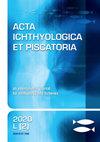突尼斯湾六种底栖和中上层鱼类(Actinopterygii)耳石质量不对称性的调查
IF 1
4区 农林科学
Q3 FISHERIES
引用次数: 4
摘要
耳石质量不对称可显著影响前庭系统功能;通常,质量不对称的X值在−0.2和+ 0.2之间变化(−0.2 < X < + 0.2)。这些值在鱼的一生中会发生变化,因此它们与鱼的总长度无关。本研究共采集突尼斯湾鱼类标本404条,其中沙丁鱼(Walbaum, 1792)(74对耳石)、地中海沙鱼(Steindachner, 1868)(66对耳石)、auratus螯龙(Risso, 1810)(60对耳石)3种中游鱼类,黑戈比斯(Gobius niger Linnaeus, 1758)(77对耳石)、梭鲈(Mullus barbatus Linnaeus, 1758)(60对耳石)、龙舌龙(Trachinus draco Linnaeus, 1758)(67对耳石)。首先计算并比较了总长度与耳石质量不对称性之间的关系,然后对其进行评价。底栖动物与远洋动物的耳石质量不对称性比较差异有统计学意义(P < 0.05),其中X的绝对平均值不超过临界值(0.2)。在底栖动物和远洋动物标本中,耳石质量不对称的大小与长度之间没有关系。环境因素对耳石生长和耳石增生有间接影响。这项研究中发现的显著差异可能是由于底栖和远洋环境的差异。本文章由计算机程序翻译,如有差异,请以英文原文为准。
Investigating otolith mass asymmetry in six benthic and pelagic fish species (Actinopterygii) from the Gulf of Tunis
Otolith mass asymmetry can significantly affect the vestibular system functionalities; usually, the X values of mass asymmetry vary between −0.2 and + 0.2 (−0.2 < X < + 0.2). These values can change during a fish life and therefore they are not related to the fish total length. We collected a total of 404 fish specimens from the Gulf of Tunis, including three pelagic species: Sardina pilchardus (Walbaum, 1792) (74 otolith pairs), Trachurus mediterraneus (Steindachner, 1868) (66 otolith pairs), and Chelon auratus (Risso, 1810) (60 otolith pairs) and three benthic species: Gobius niger Linnaeus, 1758 (77 otolith pairs), Mullus barbatus Linnaeus, 1758 (60 otolith pairs), and Trachinus draco Linnaeus, 1758 (67 otolith pairs). The relation between the total length and the otolith mass asymmetry was first calculated and compared, and then was evaluated. The comparison of the otolith mass asymmetry between benthic and pelagic species showed a significant difference (P < 0.05), where the absolute mean value of X does not exceed the critical value (0.2) for all the studied species. No relation has been found between the magnitude of the otolith mass asymmetry and the length in both benthic and pelagic specimens. Environmental factors have an indirect effect on somatic growth and otolith accretion. The significant difference found in this study can be due to the difference between the benthic and pelagic environments.
求助全文
通过发布文献求助,成功后即可免费获取论文全文。
去求助
来源期刊

Acta Ichthyologica Et Piscatoria
FISHERIES-ZOOLOGY
CiteScore
2.20
自引率
0.00%
发文量
31
审稿时长
>12 weeks
期刊介绍:
ACTA ICHTHYOLOGICA ET PISCATORIA (AIeP) is an international, peer-reviewed scientific journal that publishes articles based on original experimental data or experimental methods, or new analyses of already existing data, in any aspect of ichthyology and fisheries (fin-fish only).
 求助内容:
求助内容: 应助结果提醒方式:
应助结果提醒方式:


